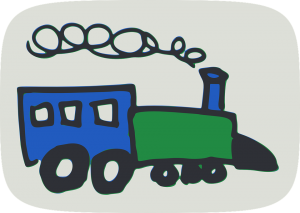
Language Development
Taking the time to teach your child a variety of nursery songs has numerous positive benefits. The first of many benefits that come from nursery songs are the development of language. Utilizing “The Wheels on the Bus Go Round” as our main example, the repetitive nature of the song promotes practicing different phonic sounds while introducing a new concept within each verse. For example, when the song changes from “The wheels on the bus go round and round” to “the doors on the bus go open and shut” introduces the idea of opposites (i.e. open and shut, up and down, and on and off). The repetitiveness of different words stimulates learning of new sounds. For example, when the wipers on the bus go swish, swish, swish, children are learning to master the “sh” sound which is present in many words they will learn as they grow.
Fine and Gross Motor Skills
Fine and gross motor skills are a crucial part of healthy child development. The difference between fine and gross motor skills starting with the fact that gross motor skills define the use and mastery of large muscle groups, i.e. learning to sit, stand, and walk. Whereas fine motor skills focus on mastery of smaller precise movements like tying a shoe, coloring within the lines, peeling off stickers and placing them on paper, and even pinching. The rhyme encourages these developmental skills because there are hand and arm movements that go along with the lyrics; in the beginning of the song while singing the lyric “…go round and round” the children are encouraged to roll their hands around each other in a circular motion. This particular motion stimulates both the fine and gross motor skill because not only are they working the larger grouped muscles of their arms, but they also have to roll their hands around each other which stimulates the development of fine motor skills.
What other topics do these songs teach your young one?
Nursery rhymes teach children between the ages of birth to five years of age other skills outside of language and physical development such as learning musical skills like rhythm, pitch, and volume. Rhyming also stimulates your child’s imagination.
The musical aspect of lyrics to wheels on the bus and similar songs gives children practice in controlling their pitch and volume when they speak. It also develops a deeper understanding of natural rhythm in everyday language. Try to imagine how you sound when you ask a question or when you try to explain a series of events that just happened to your friends or co-workers. These are concepts that children need to be able to learn and can learn these skills from popular children’s songs.
Finally, nursery songs open a child’s imagination. They can envision the bus with the wheels that go round, and round and they can imagine the wipers swishing back and forth. It is a fun and enriched way children can learn without actually knowing they are learning.
How can this be used in educational settings?
Teachers can implement a nursery rhyme during reading time at school. Most nursery lyrics are easy to remember and repeat, so teachers can take advantage by teaching a new rhyme every week. Parents can do them for fun with their children at home or even as a bedtime routine.